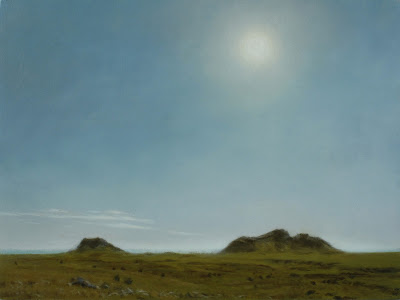oil on panel 24x18cm
I was in a gallery recently and noticed that, in one landscape, the painter had included the Sun. It struck me that all the light in my own work was indirect, and that I hadn’t really tackled how to depict the Sun full on.
I looked at how other painters had done it and did some watercolour sketches while glancing extremely briefly sunwards.
I found an interesting sunlit view to experiment with (Iceland) – and the study was going fine, but it seemed incomplete. I woke up at 5am one day with the answer – Icarus. During my Non-Painting Interval, images of Icarus had bubbled up occasionally, enough to actually note them down, so I’m quite glad that he’s made a much-delayed appearance. It’s a very small panel, and went quite well, though the light around the Sun is a little too greenish – which I’ll solve elsewhere.
There is another, much more interesting and thought-provoking, very beautiful and very moving painting that features Icarus, by Pieter Brueghel. This Flemish painter has been a favourite of mine since my early teens, and, though commonly considered a ‘pretty’ painter, his work is often very dark under closer scrutiny.
In ‘Children’s Games’ for instance, the perspective lines will direct you to an execution. This was painted in 1560, during the Reformation, when heretics were regularly burnt. The soldiers in ‘The Massacre of the Innocents’ are Spanish. At the time, there was a Flemish Protestant revolt, which was brutally suppressed by the Catholic overlord Philip II of Spain. The figure in black in the centre is the Duke of Alba - the Spanish commander. Brueghel himself considered his own private drawings and sketches so dangerous that on his deathbed, he instructed his wife to burn them.
Before I, reluctantly, leave Brueghel behind, I’ll just include W.H. Auden’s poem ‘Musee des Beaux Arts’ -
About suffering they were never wrong,
The old Masters: how well they understood
Its human position: how it takes place
While someone else is eating or opening a window or just walking dully along;
How, when the aged are reverently, passionately waiting
For the miraculous birth, there always must be
Children who did not specially want it to happen, skating
On a pond at the edge of the wood:
They never forgot
That even the dreadful martyrdom must run its course
Anyhow in a corner, some untidy spot
Where the dogs go on with their doggy life and the torturer's horse
Scratches its innocent behind on a tree.
In Breughel's Icarus, for instance: how everything turns away
Quite leisurely from the disaster; the ploughman may
Have heard the splash, the forsaken cry,
But for him it was not an important failure; the sun shone
As it had to on the white legs disappearing into the green
Water, and the expensive delicate ship that must have seen
Something amazing, a boy falling out of the sky,
Had somewhere to get to and sailed calmly on



